3 Strategies to Manage an Effective Remote Team
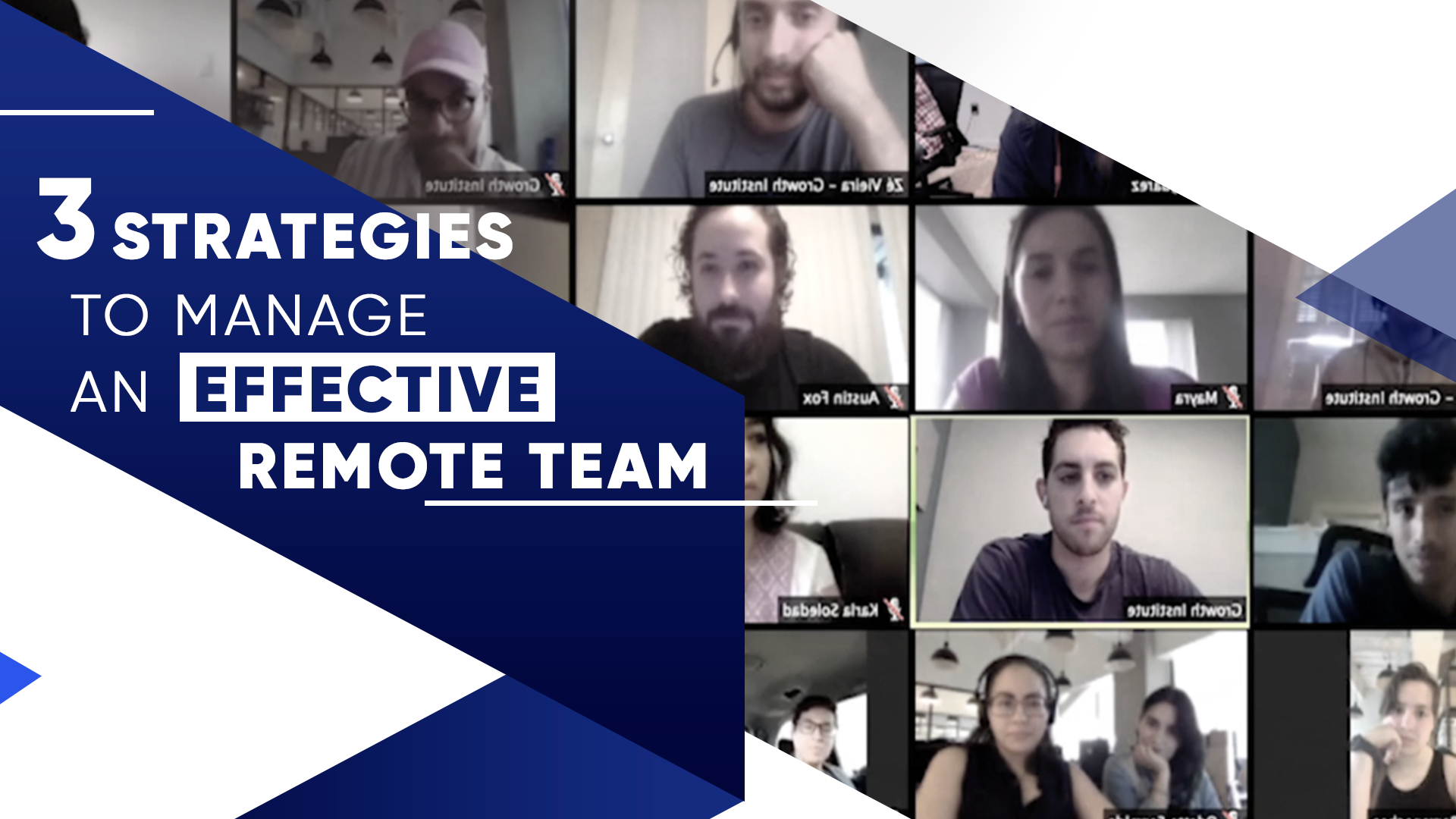
Due to the Covid-19 pandemic, many organizations find themselves handling a 100% remote team for the first time. The transition has not been seamless for many. Business leaders are scrambling to solve miscommunication, misalignment, productivity, and cash issues.
It is my — and Growth Institute’s — mission to equip business leaders with the right mindsets and strategies, so their business can survive and thrive in any unexpected situation or crisis.
That’s why I recently hosted a webinar, where I shared parts of Scaling Up framework I use to lead an effective remote working team. I’ve been using these strategies for years, and it has helped me develop a remote team that’s played a pivotal role in getting Growth Institute into the Inc. 5000 list for two years in a row.
In case you missed the live webinar, this article will summarize the main takeaways. Read on to discover everything you need to lead a productive remote workforce, from the foundational mindset to practical strategies you can apply right away.
The #1 Mindset for Remote Team Productivity
It’s only natural that your team is in a state of panic due to the global environment. People are forced to leave their jobs, stay at home, and it is unclear when things will go back to normal.. The economic impact and what this may mean in terms of job stability is on everyone’s mind.
However, YOU, as a leader, have the power to turn the tables by leading with the right mindset and strategies. To quote the wise words of my friend, Dan Martell: “Panic is contagious, but so is leadership.”
Your team’s state of mind and performance during any challenging period highly depends on your leadership. So it’s time for us, as leaders, to rise to the challenge and provide our teams with the direction they need.

The most important thing your team needs from you is the belief that your company will get through this crisis. When you make the decision to believe that, they will believe it too. The next step is following through on that belief by taking all the necessary action to survive the disruption and economic impact of the coronavirus.
One important action to take is to improve your leadership skills; and for this particular current situation, improving your skills to lead a remote team. So let’s now dive into some specific strategies you can implement right away to achieve this.
Secrets of a Highly-Engaged & Productive Remote Team
Do you know what’s the #1 mistake business leaders make when managing a remote team?
They expect technology to magically solve every issue that comes with remote working.
However, they are tools; and tools alone will not automatically create an engaged, productive team. What matters more than the tool itself is how you use the tool to drive alignment, engagement, and productivity.
Let me share a few powerful tips to drive a highly-engaged and productive remote workforce.
- Talk less, listen more
Whenever you're on virtual team calls, be the one who speaks the least. You might believe that, as a leader, you should be the one talking the most and telling others what to do. This can very quickly backfire because it will not spark engagement.
Instead, you need to ask a lot of questions and listen. If they're used to you being the only one that talks during team meetings, they won’t know what to do once they're on their own. That’s why it’s important to ask questions that will engage them, and keep them engaged, long after the meeting has ended - Play chess, not checkers
If you’re playing checkers, every piece on the board looks the same. They each have the same value; the same strengths and weaknesses. With this viewpoint, you risk oversimplifying what your team can really bring to the table.
When you play chess, however, you recognize the different skills of each member and how their strengths and weaknesses complement each other. And you begin to understand much better how to position them in your company. This can lead to better strategies and overall productivity. - Routine sets you free
The philosophy that “routine sets you free” becomes more crucial with remote workers who can easily lose focus due to the freedom (and distractions) of working away from an office.
There are two types of routines that will be important: the personal routine, and the team routine. Here, I will talk about personal routines. (We will cover team routines in a later section.)
My most important routine is my morning routine, which includes exercising, learning, and breakfast. This really fuels me for my day.
It’s important to make sure you develop a routine that fuels your productivity. You’ll also need to establish “do not disturb” work session routines, which is when those around you know not to disturb you. These can be built around the routines of other family members; for example, you could set your work routine when the spouse is doing their exercise routine or when the kids are on their playtime routine.
By leading the way with your own routines, and then helping your team to also develop their routines, you’ll maximize efficiency and productivity.
Now that we’ve covered the foundational mindsets and personal routines needed for a remote team to be effective, I’d like to talk more about the specific strategies I use from the Scaling Up methodology to manage an effective remote team.
But before I do that, let’s take a step back and recap the foundation of the Scaling Up methodology.
Managing Remote Teams with 4 Important Decisions
The Scaling Up methodology consists of four key decisions that every business leader needs to achieve organizational health and scale: Strategy, People, Execution, and Cash.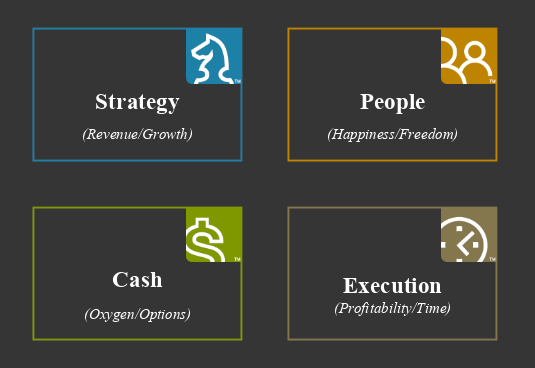
- Strategy: The success of your strategy is reflected in your revenue.
- People: The success of your people is reflected in the happiness and freedom you have with your team.
- Execution: The success of your execution is reflected in your profitability.
- Cash: The state of your cash flow reflects how effective your strategy, people, and execution are.
It’s easy for business leaders to become laser-focused on the areas of strategy, execution, and cash — after all, these are the aspects that can directly affect the bottom line. However, many business leaders forget or don’t realize that managing your team's health is what really makes a company successful.
Patrick Lencioni, author of “The Five Dysfunctions of a Team,” says, “The single greatest advantage any company can achieve is organizational health. Yet it is ignored by most leaders even though it is simple, free, and available to anyone who wants it.”
Organizations that fail to manage the success of their people will really feel the consequences of that when their team goes remote. This is why it’s important for you as a leader to lay down the solid foundations that will minimize politics and confusion, and boost morale and productivity.
When it comes to leading your people as they work from outside the office, there are three Scaling Up strategies that will serve you best.
3 Scaling Up Strategies to Lead an Effective Remote Team
In this section, I will share the three Scaling Up strategies I use with my team to minimize politics and confusion, and boost morale and productivity. These strategies are:
- One-Page Strategic Plan (OPSP)
- Communication Rhythms
- Dashboards
Let’s first look into the OPSP.
Strategy #1: One-Page Strategic Plan (OPSP)
Let me get straight to the point. Chances are, the 2020 strategy plan you put together at the end of 2019 may no longer be effective.
The economic environment has drastically shifted since the outbreak of the pandemic. It’s imperative that you quickly shift your business strategy if you want your business to survive and come out safely on the other side.
The last thing you want to do is react out of panic and haphazardly make drastic changes that may cause more harm than good. It’s important that you systematically restrategize using a proven system.
This is where the OPSP becomes a critical tool for you.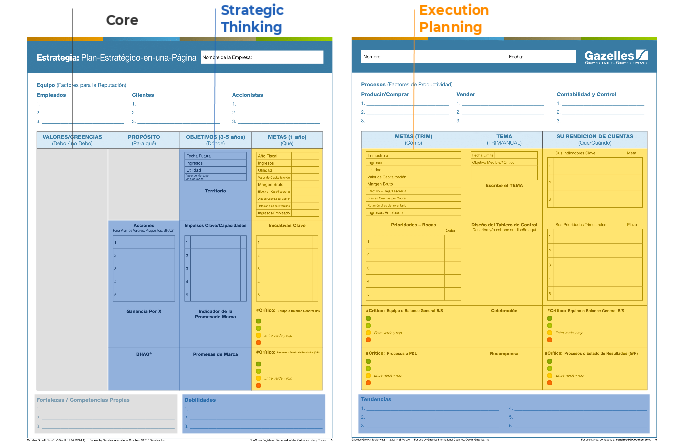
Here are three reasons why you can’t ignore the OPSP.
- It will help you systematically create a new strategy to survive the economic turbulence. Filling out the OPSP will help you identify gaps and strategize to stop the bleeding, so your business can survive this crisis.
- It allows your team to easily understand the new direction and become aligned. You don’t want to give your team a management report that’s difficult to comprehend. The OPSP distills your strategy into immediate priorities and accountabilities, which your team can quickly understand and execute without wasting precious time.
- It is foundational for the next two components (that I’ll cover below) to be effective. The OPSP will provide your team with a central focal point for smooth communication, accountability, and measurable results.
For more guidance on how to fill out the OPSP, go here.
Strategy #2: Communication Rhythms
The pulse of every company is the communication rhythm. If you want to move faster, your pulse needs to beat faster. Here are is a quick overview of the communication rhythms recommended by the Scaling Up methodology:
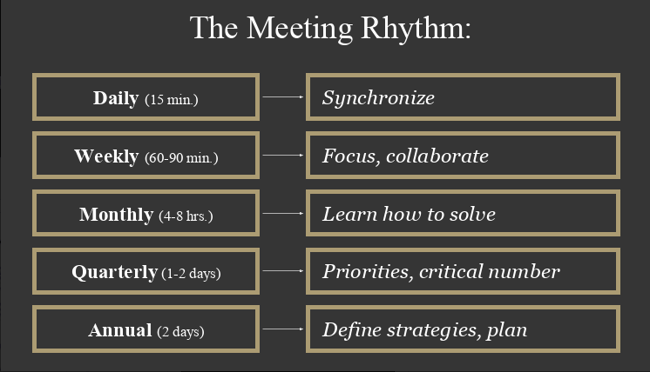
The Daily Huddle
A 5-15 minute meeting to discuss tactical issues and provide updates.
The Weekly Meeting
A 60-90 minute discussion to review progress on the quarterly priorities and address one or two main topics.
The Monthly Management Meeting
A half-day or full-day meeting, in which all senior, middle, and frontline managers come together to learn and collaboratively address one or two big issues.
The Quarterly and Annual Planning Meetings
A 1-3 day meeting where leaders establish the next quarterly and/or annual theme.
It’s important to remember that when people are in stress or are working remotely, the thing they crave the most is human connection. That’s why the best thing you can do to boost morale and productivity is give your remote team human connection and talk to them everyday.
At Growth Institute, I have a daily huddle with my remote team twice a day. I know that my team needs to hear from me at least twice a day to have clarity of what's happening. So we have a daily huddle via Zoom, twice a day, to stay aligned and motivated. Here’s what our typical Zoom daily huddles look like: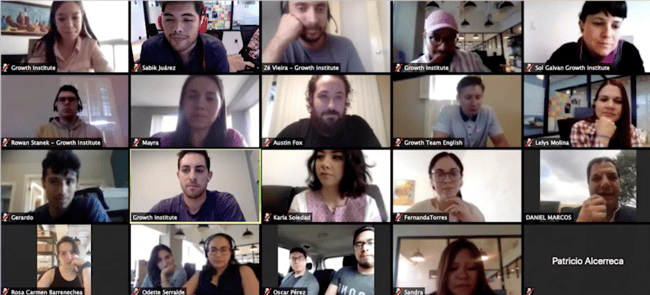
By establishing a regular communication rhythm, you will build rapport with a healthy team that is engaged, productive, and effective.
Strategy #3: Dashboards
Just as a car dashboard provides real-time information of your car’s performance and health, a business dashboard provides fast feedback on how your company and your remote team is performing.
You don’t want to rely on manually-submitted reports when you’re working with a remote team. The last thing you want to do is spend precious time chasing up people in different places (and possibly even different time zones) for their performance reports.
Once you’ve determined your KPIs, you’ll know exactly what metrics to look out for. However, you also need to set up a success criteria. 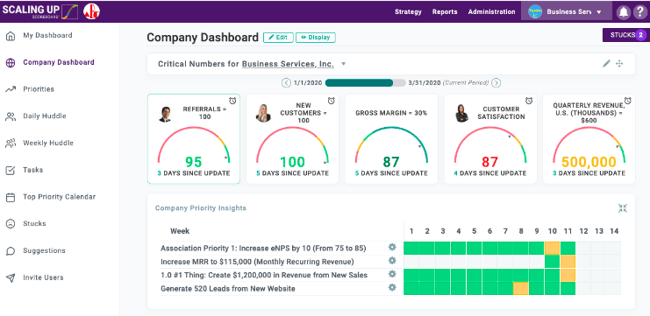
What’s a success criteria? It’s a color-coded system so you can know at a glance how your team is performing. It’s really hard to see this at a glance if all you can see is just numbers. Here’s what that can look like:
Having a clear visual will help you identify where you need to focus day by day.
Putting it All into Action
Everything that I’ve covered so far is precisely what you need to build a boat that moves faster and leaner in the water, even turbulent waters. Companies that have a strong boat will be the ones that survive and thrive. Those whose boats have holes will struggle to move forward with panic and drama.
The most important thing that you have to do right now is identify the holes in your company. Where are you leaking cash? Where are you losing productivity? What is causing the drama and politics?
If you can identify these holes and put down the measures to fix them, then you can move forward with the confidence that you’ll get through this.
To help you identify your gaps and blind spots, we provide a private implementation of our popular Scaling Up Master Business Course 2.0. This is an exclusive and unique opportunity to get expert guidance on implementing Scaling Up — targeted and tailored to your specific challenges so you can successfully bring your team through to the other side of any crisis or challenge.




